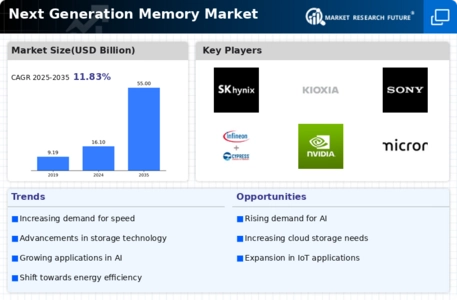Top Industry Leaders in the Next-Generation Memory Market

Competitive Landscape of the Next-Generation Memory Market
The current next-generation memory market is characterized by a fragmented landscape. Established players like Intel, Samsung, and Micron, alongside emerging contenders like SK Hynix, WDC, and emerging memory startups, are vying for dominance. This competitive landscape is further fueled by the diversity of next-generation memory technologies, each with its own set of strengths and weaknesses.
Some of the Next-Generation Memory companies listed below:
- Micron Technology, Inc.
- Toshiba Corporation
- Intel Corporation
- Samsung Electronics Co., Ltd.
- IBM Corporation
- Avalanche Technology
- Crossbar Inc.
- Fujitsu Limited
- Honeywell International Inc.
- Infineon Technologies AG
Strategies Adopted by key players:
Players in this market are adopting diverse strategies to gain an edge. Some are focusing on aggressive research and development, pouring resources into perfecting existing technologies and exploring novel ones. Others are prioritizing strategic partnerships and acquisitions, leveraging expertise and expanding market reach. Cost optimization, product differentiation, and building strong customer relationships are also key areas of focus.
Market Share Analysis: A Multifaceted Approach
Analyzing market share in this dynamic space requires a nuanced understanding of various factors. Technology leadership, production capacity, cost competitiveness, and brand reputation all play a significant role. Additionally, the diverse needs of different application segments, like consumer electronics, enterprise storage, and automotive, demand a tailored approach to market share analysis.
New Entrants and Emerging Stars:
The next-generation memory market is attracting a growing number of startups and smaller players with disruptive technologies. Companies like Everspin, Graphene Semiconductor, and Weebit are developing novel memory solutions that promise significant performance improvements and cost reductions. These emerging players are forcing established players to adapt and innovate, further accelerating the pace of technological advancements.
Latest Company Updates:
August 2023- SK Hynix has announced the launch of its new HBM3E memory which provides speeds of around 1 terabyte per second for next-generation artificial intelligence applications. The HBM3E memory runs about 10% cooler compared to predecessor products thanks to a new manufacturing process used in its production. Furthermore, the HBM3E is compatible with systems already configured for the previous HBM3 memory. SK Hynix states that the HBM3E has backwards compatibility so it can serve as a direct RAM upgrade in systems with central processing units and graphics processing units that were previously set up for HBM3. The company expects to commence mass production of the HBM3E in the first half of 2024, although it has already started providing samples to customers such as NVIDIA.
July 2023- Samsung has unveiled the world's first GDDR7 memory for upcoming high-performance graphics cards. Samsung recently announced that it has finished developing GDDR7 memory, which will be featured on next-gen premium GPUs. A single first-gen GDDR7 memory chip will have a 16 GB capacity and provide an immense 1.5 TB/s of bandwidth, making it 40% faster than the present fast GDDR6 memory with a top bandwidth of 1.1 TB/s. Samsung's GDDR7 memory utilizes Amplitude Modulation-3 (PAM3) technology that enables higher bandwidth with single modulation. Samsung's introduction of GDDR7 memory marks a major advancement in memory performance for future GPUs demanding expanded bandwidth for advanced graphics capabilities.
May 2023- Micron Technology announced it will invest up to about 500 billion yen ($3.6 billion) in Japan over the next few years, with backing from the Japanese government, to advance its position in cutting-edge memory chips. This shows that the Japanese government is vigorously moving forward with reviving its semiconductor industry and bringing chip technology into the country to bolster the chip supply chain amid growing tensions between the U.S. and China.








